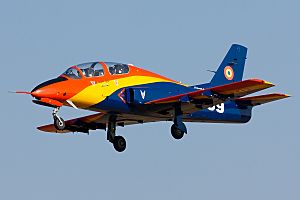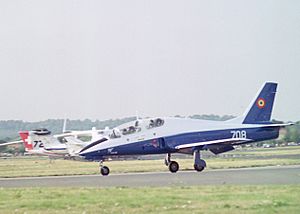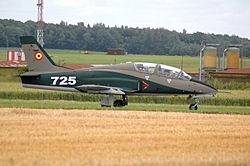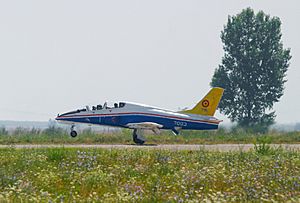IAR 99 facts for kids
Quick facts for kids IAR 99 |
|
|---|---|
 |
|
| IAR 99 of the Romanian Air Force | |
| Role | Advanced trainer and light attack aircraft |
| National origin | Romania |
| Manufacturer | Avioane Craiova |
| First flight | 21 December 1985 |
| Introduction | 1987 |
| Status | In service |
| Primary user | Romanian Air Force |
| Produced | 1985–2008 |
| Number built | 28 (25 Șoim/C 3 prototip) |
The IAR 99 Șoim (which means Hawk) is a special airplane. It's used for advanced pilot training and also as a light attack aircraft. This means it can help ground troops and fly on reconnaissance missions to gather information. The IAR 99 took the place of older jet trainers like the Aero L-29 Delfin and Aero L-39 Albatros in the Romanian Air Force.
This aircraft has a strong, lightweight body design. It features wings that get narrower towards the tips and a tail that sweeps back. A unique blade-shaped antenna under its nose makes the IAR 99 easy to recognize.
Contents
Development of the IAR 99
Work on the IAR 99 started in 1975. This was a big deal because it was the first jet trainer designed and built entirely in Romania. In 1979, money was approved to build the first trainer at Avioane Craiova SA. This is the same place where the IAR 93 attack aircraft was being built.
The very first prototype (S-001) flew on December 21, 1985. Lt. Col. Vagner Ștefănel was the pilot. Another prototype, S-002, was used for ground tests. S-003 was the second flying prototype.
The IAR 99 began being made in large numbers in 1987. By 1989, 17 of these planes were delivered to the Romanian Air Force. Sadly, two of them were lost in the 1990s.
After 1990, when the Eastern Bloc changed, there were new chances to sell the aircraft to other countries. The IAR 99 flew very well and was easy to handle. However, its electronic systems (called avionics) were old. Updating these systems became very important.
The first try at upgrading the plane happened in 1990. I.Av.Craiova worked with Jaffe Aircraft Corporation from Texas. They changed aircraft 708 and 709 by adding new Honeywell avionics. They also changed the cockpit canopy from one piece to two pieces. This two-piece design was then used for all future IAR 99 planes.
Aircraft 708 flew for the first time with the upgrades on August 8, 1990. Aircraft 709 followed on August 22. These planes were shown at the 1990 Farnborough Airshow. They were even suggested for a training program in the United States. However, no orders came from this effort. In 1991, aircraft 712 was fitted with Collins avionics and shown in Ankara, Turkey.
Later, aircraft 708, 709, and 712 were changed back to the standard version. They were then given to the Romanian Air Force.
In 1996, the upgrade program for the IAR 99 started again. This was because Romania needed a good trainer for its newly upgraded MiG-21 Lancer fighter jets. An Israeli company called Elbit was chosen to help with this. The new electronic systems were designed to work with advanced fighter jets. They were inspired by the MiG-21 Lancer upgrade but made to fit the IAR 99.
The first upgraded IAR 99 was the 18th plane built (number 718). It flew for the first time on May 22, 1997. This upgraded IAR 99 was shown at airshows in Paris in 1997 and Farnborough in 1998.
On August 6, 1998, the Romanian Government decided to start making the upgraded IAR-99 Șoim. They planned for 24 planes, with 4 ready by 2001. On April 20, 2000, the Romanian Ministry of National Defence signed a contract for these 24 aircraft. However, this number was later reduced to 12 on December 14, 2000.
Out of these 12, seven were brand new planes (numbers 719–725). The other five were older IAR 99s that were upgraded (numbers 709, 711, 712, 713, 717). These planes were delivered between 2003 and 2008. They slowly replaced the L-39 Albatros' used for training in the Romanian Air Force.
So, the Romanian Air Force now has 12 IAR 99 C Șoim (the upgraded version) and 11 IAR 99 Standard planes. Aircraft 7003 stayed with Avioane Craiova SA as a plane to show off its features.
In 2015, a group of companies announced they were working on an even better version called the IAR 99 TD. This version would have new electronic systems, a new engine, and a radar. The Leonardo Vixen 500E radar was chosen. This radar needs the plane's nose to be made longer by 900mm. A new engine that can be controlled by a computer is also needed. This new engine would replace the older Rolls-Royce Viper engine from 1951. The new engine would also need air intakes that are twice as big. A prototype was expected to be ready by 2022.
In December 2020, Elbit Systems announced they won a contract. They will upgrade the remaining 10 IAR 99 Standard planes still used by the Romanian Air Force.
Design Features
Cockpit
The IAR 99 has a cockpit with two seats, one behind the other. This is called a tandem-stepped dual-control cockpit. Both seats have Martin-Baker Mk 10 zero-zero ejection seats. These seats can safely eject the pilots even if the plane is on the ground or flying very slowly. The instructor's seat in the back is raised by 35 cm. This gives the instructor a better view.
The first planes had a single-piece canopy (like a bubble). Later, this was changed to a two-piece canopy. Both parts open to the right side of the plane.
The cockpit has HOTAS (Hands On Throttle And Stick) controls. This means pilots can control many things without taking their hands off the throttle or stick. It also has modern LCD (Liquid Crystal Display) screens. Both the pilot and instructor wear a DASH Display and Sight Helmet. This helmet helps guide the plane's weapons to where the pilot is looking. A display on the helmet's visor shows when a target is locked. It also shows information from the HUD (Head-Up Display). Important flight and navigation details are shown on the HUD, the helmet, and on color multifunction displays.
Avionics
Elbit provides the advanced electronic systems for the IAR 99. These systems are connected by a special computer network called a MIL-STD-1553B data bus. The advanced avionics, including communication, navigation, and identification systems, are similar to those in the MiG 21 LanceR and F-16 fighter jets. The IAR 99 also has systems for recording video and reviewing flights later.
The communication systems include VHF and UHF radios for talking. There's also a voice-activated intercom and an IFF transponder. The IFF helps the plane identify if other aircraft are friendly or not.
Flight systems include VOR/ILS, which helps with radio navigation and landing. Other navigation tools are distance measuring equipment (DME) and an automatic direction finder (ADF). It also has a Northrop Grumman inertial navigation system and a Trimble GPS system for finding its exact location.
One of the best features is a virtual training system. Using a data link system, pilots can practice firing weapons and air combat during a real flight. This can be done with two or more aircraft.
Countermeasures
The IAR 99 has special systems to protect it from enemy attacks. These are called electronic warfare systems. They include a radar warning receiver from Elisra Electronic Systems. This system detects if the plane is being targeted by enemy radar. It can tell what kind of radar it is by comparing signals to a threat database.
The plane also has an electronic countermeasures pod. This pod can jam enemy radar. Plus, it has a dispenser for chaff and flares. Chaff are small pieces of metal that confuse radar. Flares are hot objects that trick heat-seeking missiles. All these systems work together through the 1553 data bus.
Variants
- IAR 99 "Standard"
- This was the first version. It was designed to train pilots for the IAR-93 aircraft.
- IAR 109 "Swift"
- In 1992, an upgrade program started with IAI Lahav from Israel. This was for both the Romanian Air Force and for export. Aircraft number 7003 was given HOTAS controls in both cockpits. It also got a wide-angle HUD (Head-Up Display) in the front cockpit. There were two 3-inch displays in both cockpits and a special navigation system (ring laser gyro Inertial Navigation System). This version could also use both Eastern and Western weapon systems.
The aircraft was shown at the 1993 Paris Air Show and flew at Asian Aerospace in 1994. There was a plan to sell 10 planes to Botswana, but it was stopped. This ended the work with IAI. Aircraft 7003 was then changed back to the "Standard" version. It was sent to the center for flight research and testing (CCIZ). As late as 2009, it still had its "Swift" paint design and logo.
- IAR 99 C "Șoim"
- This is the upgraded version. It uses electronic systems from Elbit Systems.
- IAR 99 TD
- This is a technical demonstrator plane that is still being developed.
Operators
- Romanian Air Force - They currently have 20 of these aircraft in service.
Notable accidents and incidents
- On August 14, 1986, aircraft S-002 crashed. Both pilots, Lt. Col. Mihai Ionescu and Mj. Mitiță Stoica, safely ejected.
- On June 26, 1990, aircraft S-001 crashed during an air show practice. The left wing hit the runway during an inverted flight. Lt. Col. Ștefănel Vagner and Lt. Col. Mihai Ionescu died in this accident.
- On February 24, 1994, aircraft 710 caught fire while on the ground. No one was hurt.
- On March 30, 1995, aircraft 714 had a fuel line break, which caused a fire. Both people on board ejected safely.
- On September 24, 2004, aircraft 721 (a Șoim version) hit a bird. The bird hit the cockpit, and parts of it went into the engine. The crew tried to make an emergency landing and were badly hurt when they crashed, but they recovered. The plane was too damaged to be repaired.
- On August 23, 2012, aircraft 718 (a Standard version) crashed shortly after taking off during a training flight. The instructor in the back seat ejected safely but had serious injuries. Sadly, the student died.
- On July 16, 2018, aircraft 723 (a Șoim version) crashed after both people on board ejected safely. People watching said they saw smoke coming from the plane before it crashed.
Specifications
Data from Avioane Craiova SA, Jane's all the World's Aircraft 2004-05
General characteristics
- Crew: 2
- Length: 11.01 m (36 ft 1 in)
- Wingspan: 9.85 m (32 ft 4 in)
- Height: 3.9 m (12 ft 10 in)
- Wing area: 18.71 m2 (201.4 sq ft)
- Aspect ratio: 5.2
- Airfoil: NACA 641A-214 (modified)
- Empty weight: 3,200 kg (7,055 lb) equipped
- Max takeoff weight: 4,400 kg (9,700 lb) Trainer; 5,560 kg (12,260 lb) Ground attack
- Fuel capacity: Internal:1,370 L (360 US gal; 300 imp gal); External:up to 450 L (120 US gal; 99 imp gal) (in 225 L (59 US gal; 49 imp gal) drop tanks)
- Powerplant: 1 × Turbomecanica/Rolls-Royce Viper Mk632-41M turbojet, 17.79 kN (4,000 lbf) thrust
Performance
- Maximum speed: 865 km/h (537 mph; 467 kn) trainer, clean
- Maximum speed: Mach 0.76
- Range: 1,100 km (684 mi; 594 nmi) Trainer with internal fuel; Ground attack with internal fuel 967 km (601 mi; 522 nmi)
- Combat range: 345 km (214 mi; 186 nmi) hi-lo-hi at 5,280 kg (11,640 lb)all-up weight
- Service ceiling: 12,900 m (42,300 ft)
- g limits: +7 / -3.6
- Rate of climb: 35 m/s (6,900 ft/min) at Sea level
- Wing loading: 235.2 kg/m2 (48.2 lb/sq ft) Trainer; 297.2 kg/m2 (60.9 lb/sq ft) Ground attack
Armament
- Guns: 1 × 23 mm Gryazev-Shipunov GSh-23L autocannon (a powerful machine gun)
- Hardpoints: 4 underwing hardpoints (places to attach things) capable of holding 250 kg each and 1 central hardpoint capable of holding 400 kg with a capacity of up to 450 kg (990 lb) of stores (the underwing hardpoints can carry 225l drop tanks for extra fuel),
- Rockets:
- LPR 57 (small missiles)
- Missiles:
- R-60 air-to-air missile (for attacking other planes)
- Python AAM
- R.550 Magic AAM
- Bombs:
- BEM 250
- BE 100
- BE 50
- Mk 82 general-purpose bomb
- Opher infrared-guided bomb
- Laser-guided bombs
See also
 In Spanish: IAR 99 para niños
In Spanish: IAR 99 para niños
- Similar aircraft
- Aermacchi MB-339 - same engine and role
- Aero L-59 Super Albatros
- BAE Systems Hawk
- FMA IA 63 Pampa
- Mikoyan MiG-AT
- PZL I-22 Iryda
- Soko G-4 Super Galeb
- Kawasaki T-4
- CASA C-101




